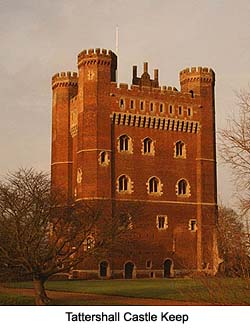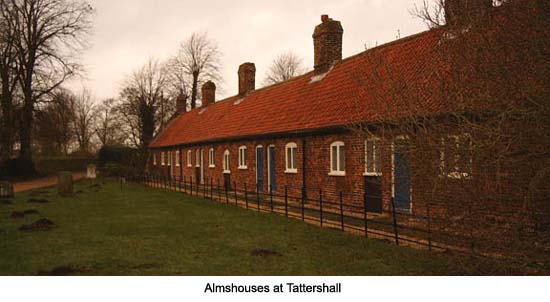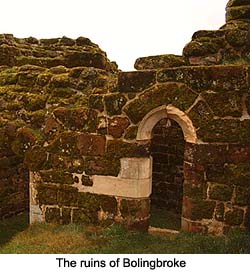Tattershall and Bolingbroke: A Tale of Two Castles
by Mary Cook
 Nothing quite prepares you for the breathtaking sight
of sunlight on rosy medieval brick -- not when that brick has
been fashioned into a storybook castle keep. Nothing quite prepares you for the breathtaking sight
of sunlight on rosy medieval brick -- not when that brick has
been fashioned into a storybook castle keep.
Tattershall Castle, at Tattershall, a village in the historic
county of Lincolnshire, is on the A153 road between Sleaford and
Horncastle, about three-and-a-half miles from Woodhall Spa. Henry
VIII (1491-1547) said of the county of Lincolnshire that it was
"one of the most brutal and beestlie of the whole realm." But
today it's arguably one of the most beautiful, with much of its
heritage sensitively preserved.
"An Englishman's home is his castle," the well-known saying goes.
But in the case of Tattershall Castle, an Englishman's castle was
his home. The castle, on the site of an earlier one built in the
13th century by Robert de Tateshall, was raised between 1433 and
1443 by Ralph Cromwell, Lord Treasurer to King Henry VI. An
Agincourt veteran, he had inherited the estate in 1419. This is
no cozy family home but a manor house, fortified and
double-moated to impress -- an affirmation of power. And Cromwell
was recognized as being among the most powerful men of his
time.
The keep is all that is left of the castle today. Built in a
square formation, it has a hexagonal tower at each corner and
stands more than a hundred feet above ground level. If you climb
the 150 steps to the battlements, it's said that on a clear day
you can see Boston "Stump" -- the distinctive truncated tower of
St Botolph's Church, Boston, about 14 miles away -- and Lincoln
Cathedral, about 17 miles away.
Cromwell was a philanthropist whose work lives on in Tattershall
where he founded a church, a college for the education of the
church choristers, and a row of almshouses -- all forming part of
the castle complex.
The church and almshouses still grace the landscape to this
day. In fact the almshouses were renovated in the late 1960s.
Dedicated to the Holy Trinity, the church boasts a fine medieval
glass window and a prized collection of brasses. Near the font is
a plaque marking the grave of Tattershall's famous local
resident, "Tom Thumb," who was just 18 inches tall and died in
1620, aged 101. His tiny house can be seen on the roof of
another, larger house in the village. The college, a splendid
example of Gothic architecture in the perpendicular style, is now
a ruin. Those walls that remain "perpendicular" have been shored
up with modern brick.

Cromwell died childless. Little has been recorded of the
castle's history after his death except that the property
reverted to the Crown and later passed into the hands of
successive Earls of Lincoln.
Despite the appearance of having been built for warfare,
Tattershall Castle saw little English Civil War action, as it was
garrisoned for Parliament throughout most of the conflict, though
it was captured and briefly held by the King's men in 1643.
Having fallen into disrepair over the centuries, it was
eventually bought in 1911 by Lord Curzon, Viceroy of India, who
restored the keep in 1914. One of his more significant
improvements was to reinstate the Gothic fireplaces that had been
taken out to be sold abroad. On his death in 1925, Lord Curzon
bequeathed the property to the National Trust, which now opens it
to the public on designated days from March through December.
Nowadays Tattershall Castle is still making a lasting impression
with its displays of medieval tapestries, stained glass and
massive pieces of old oak furniture. Heraldic symbols remind us
of Cromwell's elevated position as Henry VI's Treasurer. Peacocks
roam the extensive grounds and have been known to bring traffic
to a standstill by wandering through the village. Both moats are
home to wildfowl and other wildlife. Visitors can buy coffee and
souvenirs in the National Trust shop or take a picnic in the
grounds. And changes to licensing laws in recent years mean you
can even get married in the castle keep.
There are further reminders that we're living in a modern age
when airplanes take off and land at the Royal Air Force base at
nearby Coningsby, home to the Battle of Britain Flight -- a fleet
of World War II aircraft, lovingly preserved and flown on
ceremonial occasions. But nothing can detract from the medieval
magic that is Tattershall Castle!
Bolingbroke Castle
Bolingbroke Castle can be found eleven miles north-east of
Tattershall in the Royal village of Old Bolingbroke. Originally
just "Bolingbroke," it was later given the "Old" prefix to
distinguish it from "New" Bolingbroke, a village built by local
landowner John Parkinson in the early 19th century as part of a
threefold ambition to sink a coalmine, to build a "city" and to
plant a forest.
 In contrast to Tattershall
Castle, Bolingbroke Castle is a total ruin, with only the lower
portions of the main walls visible. But while there's little to
see at Bolingbroke, there's plenty to feel. Its mossy
stones are steeped in history. Their brooding presence hints
heavily of the Plague and ancient acts of bloodshed. It's not
hard to visualize what the castle must have looked like when you
trace the outline of the 12-foot thick walls. Vestiges remain of
five towers and a gatehouse. It would surely have been a
magnificent building in its day. A lifting mechanism found
during excavations show that there must have been a drawbridge
over the moat. In contrast to Tattershall
Castle, Bolingbroke Castle is a total ruin, with only the lower
portions of the main walls visible. But while there's little to
see at Bolingbroke, there's plenty to feel. Its mossy
stones are steeped in history. Their brooding presence hints
heavily of the Plague and ancient acts of bloodshed. It's not
hard to visualize what the castle must have looked like when you
trace the outline of the 12-foot thick walls. Vestiges remain of
five towers and a gatehouse. It would surely have been a
magnificent building in its day. A lifting mechanism found
during excavations show that there must have been a drawbridge
over the moat.
Unlike most castles, Bolingbroke didn't command a high vantage
point. The stone fortress was founded in the 13th century by Sir
Randulf de Blundeville, Earl of Chester. A powerful and
politically active man as well as a soldier, he was created Earl
of Lincoln 1217 for his services to the Crown.
When Randulph died, Bolingbroke Castle passed to his nephew by
marriage, John de Lacy, who also became Earl of Lincoln. On his
death, the castle was inherited by his daughter Alice, who was
married to Earl Thomas of Lancaster. Thomas's life ended in
execution, so when Alice died there was no immediate heir to the
estate. Bolingbroke then passed to Henry, brother to Alice's
first husband.
Henry's daughter Blanche married John of Gaunt, who became the
1st Duke of Lancaster. The castle was the birthplace in 1366 to
their son, Henry Bolingbroke, later to become King Henry IV.
Blanche died there of the Plague, aged just 24.
Once he was made King, Henry never returned to the home of his
birth and the castle was neglected. As it was built mainly of
local sandstone, which was not very durable, it soon fell into
disrepair. Of the five towers, only the King's Tower, which was
rebuilt between 1444 and 1556, remained habitable, along with the
gatehouse. A survey in 1632 stated that the King's Tower was the
only one still capable of being repaired. And even that had
fallen into decay by the time of the outbreak of the English
Civil War in 1642 which saw the castle brought into service as a
Royalist stronghold against the Parliamentarians, nicknamed
Roundheads from the shape of their protective headgear.
The castle was held by Royalist troops but came under siege and
surrendered after the Parliamentary victory in 1643 at the Battle
of Winceby, three miles to the north. The small, brief battle was
bloody but strategic in securing the county of Lincolnshire for
Parliament.Today, there is nothing to show for the conflict but a
memorial stone marking the scene of the battle.
Although victory was finally claimed by the Parliamentarians in
1651, there were fears of a Royalist resurgence. To avoid the
possibility of recapture, the castle was rendered indefensible on
an order from Parliament somewhere around the middle of the 17th
century. A survey of 1654 describes Bolingbroke Castle as
"demolished". The last remaining walls collapsed in 1815.
Today the pleasant but unassuming village has little to show of
its proud Royal heritage, though the fabric of the castle lives
on in some of the local cottages, stone from the site having been
salvaged by villagers for building purposes. There is little
danger of Bolingbroke's history being consigned entirely to the
past, however, as the English Civil War Society exists to stage
reenactments of Civil War events. In 2003 the society performed
an authentic reenactment of the Siege of Bolingbroke and the
Battle of Winceby, marking the 360th anniversary of those
events.
Where to Stay and What to See
Visitors wishing to see Tattershall and Bolingbroke would do
well to make Woodhall Spa their touring base. Situated about 20
miles south east of the city of Lincoln, it's a quaint
"stage-set" of a town that grew up after curative waters were
accidentally discovered in the early19th century, giving Woodhall
its spa status.
Woodhall's attractions include a cottage museum, which houses the
Tourist Information Centre. Displays outline the history of the
spa, together with that of the world-famous "Dambusters," the
elite 617 Squadron of the Royal Air Force, whose officers'
wartime mess was to be found in the Petwood Hotel. A magnificent
plantation of pine and beech woods serves as a backdrop to the
town. There you'll find the quaint Kinema in the Woods, England's
only back projection cinema. It opened in 1922 and in its heyday
was patronized by Royalty.
Related Articles:
- Boston of the Fenlands and Its Stump, by Lisa Agnew
- https://www.timetravel-britain.com/articles/towns/boston.shtml
More Information:
We regret that we no longer have the resources to maintain up-to-date links and/or hours and pricing details for the various sites and attractions listed on this website. For more information about the location(s) listed above, please use your favorite search engine or visit Wikipedia.
Mary Cook has been freelancing for nearly 17 years, and
has published numerous articles, short stories and poems in print
and online publications. Her primary interests are humor,
self-sufficient living, and the craft and business of writing.
She lives in the county of Lincolnshire, "arguably one of
the most beautiful and historic areas in the UK," and was a
reporter for a regional paper for more than five years, during
which time she provided most of the editorial content for the
paper's annual tourist guides.
Article and photos © 2006 Mary Cook
|
